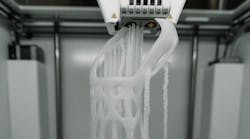Change is tough. However, with the right mix of openness to explore new capabilities and a willingness to experiment, the results can be surprising. It is a common scenario when traditional manufacturers bring additive technology into the fold.
Consider Rochester Hills-based Air & Liquid Systems, who is using its 3D printer to print a part that was previously made of stainless steel and cost $100; it now costs them only $1 to make it out of carbon fiber. Their printer is placed in their engineering area to make the engineers more curious about what else they can create, shifting the way they think about production and their business. For CEO Jim Miller, it is exciting to see the culture change of integrating new technology into manufacturing that positions the organization for gains on its journey to Industry 4.0.
Additionally, Josh Tucker of Shelby Township, Mich.-based Tucker Induction System was surprised by how quickly his company was able to produce 3D-printed parts that proved to withstand tension, heat, and other forces seen in real-world scenarios. The company is now not only 3D printing some parts that were previously produced using subtractive manufacturing methods, but also using 3D printing to develop completely new solutions.
These are just two examples of manufacturers located within Automation Alley, Michigan’s Industry 4.0 knowledge center and a World Economic Forum Advanced Manufacturing Hub (AMHUB) for North America. Like many others within the region, they are taking part in Project DIAMOnD (Digital, Independent, Agile, Manufacturing on Demand), an initiative to create the country’s largest 3D printer network on a blockchain technology platform.
The initiative was established through the CARES ACT leveraging grants award to Automation Alley by Oakland and Macomb Counties to accelerate digital transformation among Michigan manufacturers and strengthen supply chains for developing PPE during the pandemic. Simultaneously, Project DIAMOnD participating manufacturers are able to use the Markforged 3D printers they receive to expand their production of a variety of industrial parts and products, ultimately enhancing Industry 4.0 manufacturing capabilities in Michigan and throughout the nation.
Tom Kelly, executive director and CEO of Automation Alley, tells IndustryWeek the primary goal in building the network of 3D printers is twofold. “First, we wanted to strengthen Michigan's supply chain for developing PPE during the pandemic,” he says. “Second, by introducing 3D printing technology to small and medium-sized manufacturers, we are enhancing Industry 4.0 manufacturing capabilities in Michigan, because when they are not producing PPE, Project DIAMOnD participating manufacturers are able to use the 3D printers they received for their own business use to expand their production of a variety of industrial parts and products."
While many small manufacturers were eager to learn and begin using their printers immediately right away, one of the main hurdles was that not all SMEs saw the value right away, explains Kelly. “These are companies that have been using subtractive manufacturing techniques for decades. Getting companies to buy in, accept change and embrace digital technologies is always a challenge,” he says. “However, we have been thrilled to see the culture change of integrating new technology into manufacturing that positions these companies for gains on their journey to Industry 4.0."
Having recently placed the milestone 300th machine, Kelly touts Project DIAMOnD as the world’s largest independent and distributed 3D printing network. “It is advancing our mission to accelerate the digital transformation of Michigan’s small and medium-sized manufacturers, and our goal is to expand this connected community well beyond the 300 3D printers that are now deployed across Southeast Michigan,” says Kelly. “The long-term objective of Project DIAMOnD is to facilitate the creation of a self-governing, open and scalable marketplace implemented using the decentralized principles of blockchain technology. The most compelling reason blockchain is being used is because the network will govern itself.”




